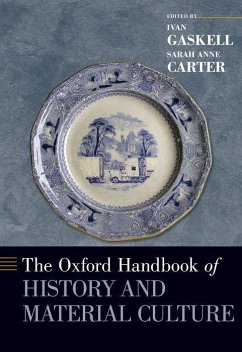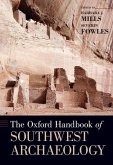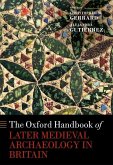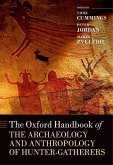The Oxford Handbook of History and Material Culture
Herausgeber: Gaskell, Ivan; Carter, Sarah Anne
Schade – dieser Artikel ist leider ausverkauft. Sobald wir wissen, ob und wann der Artikel wieder verfügbar ist, informieren wir Sie an dieser Stelle.
The Oxford Handbook of History and Material Culture
Herausgeber: Gaskell, Ivan; Carter, Sarah Anne
- Gebundenes Buch
- Merkliste
- Auf die Merkliste
- Bewerten Bewerten
- Teilen
- Produkt teilen
- Produkterinnerung
- Produkterinnerung
Most historians rely principally on written sources. Yet there are other traces of the past available to historians: the material things that people have chosen, made, and used. This book examines how material culture can enhance historians' understanding of the past, both worldwide and across time. Deploying material culture to discover the pasts of constituencies who have left few traces in written record, the authors present familiar historical problems in new ways. This volume offers case studies arranged thematically in six sections that address the relationship of history and material…mehr
Andere Kunden interessierten sich auch für
![The Oxford Handbook of Light in Archaeology The Oxford Handbook of Light in Archaeology]() The Oxford Handbook of Light in Archaeology253,99 €
The Oxford Handbook of Light in Archaeology253,99 €![The Oxford Handbook of Islamic Archaeology The Oxford Handbook of Islamic Archaeology]() The Oxford Handbook of Islamic Archaeology253,99 €
The Oxford Handbook of Islamic Archaeology253,99 €![The Oxford Handbook of Southwest Archaeology The Oxford Handbook of Southwest Archaeology]() The Oxford Handbook of Southwest Archaeology253,99 €
The Oxford Handbook of Southwest Archaeology253,99 €![The Oxford Handbook of the Archaeology and Anthropology of Body Modification The Oxford Handbook of the Archaeology and Anthropology of Body Modification]() ManniThe Oxford Handbook of the Archaeology and Anthropology of Body Modification301,99 €
ManniThe Oxford Handbook of the Archaeology and Anthropology of Body Modification301,99 €![Art and Material Culture in the Byzantine and Islamic Worlds Art and Material Culture in the Byzantine and Islamic Worlds]() Art and Material Culture in the Byzantine and Islamic Worlds139,99 €
Art and Material Culture in the Byzantine and Islamic Worlds139,99 €![Oxford Handbook of Later Medieval Archaeology in Britain Oxford Handbook of Later Medieval Archaeology in Britain]() Christopher M GerrardOxford Handbook of Later Medieval Archaeology in Britain230,99 €
Christopher M GerrardOxford Handbook of Later Medieval Archaeology in Britain230,99 €![The Oxford Handbook of the Archaeology and Anthropology of Hunter-Gatherers The Oxford Handbook of the Archaeology and Anthropology of Hunter-Gatherers]() The Oxford Handbook of the Archaeology and Anthropology of Hunter-Gatherers305,99 €
The Oxford Handbook of the Archaeology and Anthropology of Hunter-Gatherers305,99 €-
-
-
Most historians rely principally on written sources. Yet there are other traces of the past available to historians: the material things that people have chosen, made, and used. This book examines how material culture can enhance historians' understanding of the past, both worldwide and across time. Deploying material culture to discover the pasts of constituencies who have left few traces in written record, the authors present familiar historical problems in new ways. This volume offers case studies arranged thematically in six sections that address the relationship of history and material culture to cognition, technology, the symbolic, social distinction, and memory.
Produktdetails
- Produktdetails
- Verlag: Hurst & Co.
- Seitenzahl: 680
- Erscheinungstermin: 15. Mai 2020
- Englisch
- Abmessung: 249mm x 180mm x 41mm
- Gewicht: 1338g
- ISBN-13: 9780199341764
- ISBN-10: 0199341761
- Artikelnr.: 58306233
- Herstellerkennzeichnung
- Libri GmbH
- Europaallee 1
- 36244 Bad Hersfeld
- gpsr@libri.de
- Verlag: Hurst & Co.
- Seitenzahl: 680
- Erscheinungstermin: 15. Mai 2020
- Englisch
- Abmessung: 249mm x 180mm x 41mm
- Gewicht: 1338g
- ISBN-13: 9780199341764
- ISBN-10: 0199341761
- Artikelnr.: 58306233
- Herstellerkennzeichnung
- Libri GmbH
- Europaallee 1
- 36244 Bad Hersfeld
- gpsr@libri.de
Ivan Gaskell is Professor of Cultural History and Museum Studies at Bard Graduate Center in New York City. Sarah Anne Carter is Visiting Executive Director of the Center for Design and Material Culture and Visiting Assistant Professor of Design Studies at the University of Wisconsin-Madison
* Introduction: Why History and Material Culture? by Ivan Gaskell and
Sarah Anne Carter
* Part 1
* History, Material Culture, and Cognition
* Chapter 1: Words or Things in American History? by Steven Conn
* Chapter 2: Artifacts and their Functions, by A.W. Eaton
* Chapter 3: Mastery, Artifice, and the Natural Order: A Jewel from the
Early Modern Pearl Industry, by Mónica Domínguez Torres
* Chapter 4: Food and Cognition: Henry Norwood's A Voyage to Virginia,
by Bernard L. Herman
* Chapter 5: On Pins and Needles: Straight Pins, Safety Pins, and
Spectacularity, by Amber Jamilla Musser
* Chapter 6: Mind, Time, and Material Engagement, by Lambros Malafouris
and Chris Gosden
* Part 2
* History, Material Culture, and Technology
* Chapter 7: Material Time, by John Robb
* Chapter 8: Remaking the Kitchen, 1800-1850, by J. Ritchie Garrison
* Chapter 9: Boston Electric: Science by "Mail Order" and Bricolage at
Colonial Harvard, by Sara J. Schechner
* Chapter 10: Making Knowledge Claims in the Eighteenth-Century British
Museum, by Ivan Gaskell
* Chapter 11: The Ever-Changing Technology and Significance of Silk on
the Silk Road, by Zhao Feng
* Chapter 12: Science, Play, and the Material Culture of
Twentieth-Century American Boyhood, by Rebecca Onion
* Part 3
* History, Material Culture, and the Symbolic
* Chapter 13: The Sensory Web of Vision: Enchantment and Agency in
Religious Material Culture, by David Morgan
* Chapter 14: Sensiotics, or the Study of the Senses in Material
Culture and History in Africa and Beyond, by Henry John Drewal
* Chapter 15: The Numinous Body and the Symbolism of Human Remains, by
Christopher Allison
* Chapter 16: Symbolic Things and Social Performance: Christmas
Nativity Scenes in Late Nineteenth-Century Santiago de Chile, by
Olaya Sanfuentes
* Chapter 17: Heritage Religion and the Mormons, by Colleen McDannell
* Chapter 18: From Confiscation to Collection: The Objects of China's
Cultural Revolution, by Denise Y. Ho
* Part 4
* History, Material Culture, and Social Distinction
* Chapter 19: Persons and Things in Marseille and Lucca, 1300-1450, by
Daniel Lord Smail
* Chapter 20: Cloth and the Rituals of Encounter in La Florida: Weaving
and Unraveling the Code, by Laura Johnson
* Chapter 21: Street "Luxuries": Food Hawking in Early Modern Rome, by
Melissa Calaresu
* Chapter 22: Ebony and Ivory: Pianos, People, Property, and Freedom on
the Plantation, 1861-1870, by Dana E. Byrd
* Chapter 23: The Material Culture of Furniture Production in the
British Colonies, by Edward S. Cooke, Jr.
* Chapter 24: Material Culture, Museums and the Creation of Multiple
Meanings, by Neil G. W. Curtis
* Part 5
* History, Material Culture, and Memory
* Chapter 25: Chronology and Time: Northern European Coastal
Settlements and Societies, c. 500-1050, by Christopher Loveluck
* Chapter 26: Materialities in the Making of World Histories: South
Asia and the South Pacific, by Sujit Sivasundaram
* Chapter 27: Mapping History in Clay and Skin: Strategies for
Remembrance among Ga'anda of Northeastern Nigeria, by Marla C. Berns
* Chapter 28: Remember Me: Sensibility and the Sacred in Early
Mormonism, by Laurel Thatcher Ulrich
* Chapter 29: Housing History: The Colonial Revival as Consumer
Culture, by Thomas Denenberg
* Chapter 30: Collecting as Historical Practice and the Conundrum of
the Unmoored Object, by Catherine Whalen
* Conclusion: The Meaning of Things, by Peter Burke
Sarah Anne Carter
* Part 1
* History, Material Culture, and Cognition
* Chapter 1: Words or Things in American History? by Steven Conn
* Chapter 2: Artifacts and their Functions, by A.W. Eaton
* Chapter 3: Mastery, Artifice, and the Natural Order: A Jewel from the
Early Modern Pearl Industry, by Mónica Domínguez Torres
* Chapter 4: Food and Cognition: Henry Norwood's A Voyage to Virginia,
by Bernard L. Herman
* Chapter 5: On Pins and Needles: Straight Pins, Safety Pins, and
Spectacularity, by Amber Jamilla Musser
* Chapter 6: Mind, Time, and Material Engagement, by Lambros Malafouris
and Chris Gosden
* Part 2
* History, Material Culture, and Technology
* Chapter 7: Material Time, by John Robb
* Chapter 8: Remaking the Kitchen, 1800-1850, by J. Ritchie Garrison
* Chapter 9: Boston Electric: Science by "Mail Order" and Bricolage at
Colonial Harvard, by Sara J. Schechner
* Chapter 10: Making Knowledge Claims in the Eighteenth-Century British
Museum, by Ivan Gaskell
* Chapter 11: The Ever-Changing Technology and Significance of Silk on
the Silk Road, by Zhao Feng
* Chapter 12: Science, Play, and the Material Culture of
Twentieth-Century American Boyhood, by Rebecca Onion
* Part 3
* History, Material Culture, and the Symbolic
* Chapter 13: The Sensory Web of Vision: Enchantment and Agency in
Religious Material Culture, by David Morgan
* Chapter 14: Sensiotics, or the Study of the Senses in Material
Culture and History in Africa and Beyond, by Henry John Drewal
* Chapter 15: The Numinous Body and the Symbolism of Human Remains, by
Christopher Allison
* Chapter 16: Symbolic Things and Social Performance: Christmas
Nativity Scenes in Late Nineteenth-Century Santiago de Chile, by
Olaya Sanfuentes
* Chapter 17: Heritage Religion and the Mormons, by Colleen McDannell
* Chapter 18: From Confiscation to Collection: The Objects of China's
Cultural Revolution, by Denise Y. Ho
* Part 4
* History, Material Culture, and Social Distinction
* Chapter 19: Persons and Things in Marseille and Lucca, 1300-1450, by
Daniel Lord Smail
* Chapter 20: Cloth and the Rituals of Encounter in La Florida: Weaving
and Unraveling the Code, by Laura Johnson
* Chapter 21: Street "Luxuries": Food Hawking in Early Modern Rome, by
Melissa Calaresu
* Chapter 22: Ebony and Ivory: Pianos, People, Property, and Freedom on
the Plantation, 1861-1870, by Dana E. Byrd
* Chapter 23: The Material Culture of Furniture Production in the
British Colonies, by Edward S. Cooke, Jr.
* Chapter 24: Material Culture, Museums and the Creation of Multiple
Meanings, by Neil G. W. Curtis
* Part 5
* History, Material Culture, and Memory
* Chapter 25: Chronology and Time: Northern European Coastal
Settlements and Societies, c. 500-1050, by Christopher Loveluck
* Chapter 26: Materialities in the Making of World Histories: South
Asia and the South Pacific, by Sujit Sivasundaram
* Chapter 27: Mapping History in Clay and Skin: Strategies for
Remembrance among Ga'anda of Northeastern Nigeria, by Marla C. Berns
* Chapter 28: Remember Me: Sensibility and the Sacred in Early
Mormonism, by Laurel Thatcher Ulrich
* Chapter 29: Housing History: The Colonial Revival as Consumer
Culture, by Thomas Denenberg
* Chapter 30: Collecting as Historical Practice and the Conundrum of
the Unmoored Object, by Catherine Whalen
* Conclusion: The Meaning of Things, by Peter Burke
* Introduction: Why History and Material Culture? by Ivan Gaskell and
Sarah Anne Carter
* Part 1
* History, Material Culture, and Cognition
* Chapter 1: Words or Things in American History? by Steven Conn
* Chapter 2: Artifacts and their Functions, by A.W. Eaton
* Chapter 3: Mastery, Artifice, and the Natural Order: A Jewel from the
Early Modern Pearl Industry, by Mónica Domínguez Torres
* Chapter 4: Food and Cognition: Henry Norwood's A Voyage to Virginia,
by Bernard L. Herman
* Chapter 5: On Pins and Needles: Straight Pins, Safety Pins, and
Spectacularity, by Amber Jamilla Musser
* Chapter 6: Mind, Time, and Material Engagement, by Lambros Malafouris
and Chris Gosden
* Part 2
* History, Material Culture, and Technology
* Chapter 7: Material Time, by John Robb
* Chapter 8: Remaking the Kitchen, 1800-1850, by J. Ritchie Garrison
* Chapter 9: Boston Electric: Science by "Mail Order" and Bricolage at
Colonial Harvard, by Sara J. Schechner
* Chapter 10: Making Knowledge Claims in the Eighteenth-Century British
Museum, by Ivan Gaskell
* Chapter 11: The Ever-Changing Technology and Significance of Silk on
the Silk Road, by Zhao Feng
* Chapter 12: Science, Play, and the Material Culture of
Twentieth-Century American Boyhood, by Rebecca Onion
* Part 3
* History, Material Culture, and the Symbolic
* Chapter 13: The Sensory Web of Vision: Enchantment and Agency in
Religious Material Culture, by David Morgan
* Chapter 14: Sensiotics, or the Study of the Senses in Material
Culture and History in Africa and Beyond, by Henry John Drewal
* Chapter 15: The Numinous Body and the Symbolism of Human Remains, by
Christopher Allison
* Chapter 16: Symbolic Things and Social Performance: Christmas
Nativity Scenes in Late Nineteenth-Century Santiago de Chile, by
Olaya Sanfuentes
* Chapter 17: Heritage Religion and the Mormons, by Colleen McDannell
* Chapter 18: From Confiscation to Collection: The Objects of China's
Cultural Revolution, by Denise Y. Ho
* Part 4
* History, Material Culture, and Social Distinction
* Chapter 19: Persons and Things in Marseille and Lucca, 1300-1450, by
Daniel Lord Smail
* Chapter 20: Cloth and the Rituals of Encounter in La Florida: Weaving
and Unraveling the Code, by Laura Johnson
* Chapter 21: Street "Luxuries": Food Hawking in Early Modern Rome, by
Melissa Calaresu
* Chapter 22: Ebony and Ivory: Pianos, People, Property, and Freedom on
the Plantation, 1861-1870, by Dana E. Byrd
* Chapter 23: The Material Culture of Furniture Production in the
British Colonies, by Edward S. Cooke, Jr.
* Chapter 24: Material Culture, Museums and the Creation of Multiple
Meanings, by Neil G. W. Curtis
* Part 5
* History, Material Culture, and Memory
* Chapter 25: Chronology and Time: Northern European Coastal
Settlements and Societies, c. 500-1050, by Christopher Loveluck
* Chapter 26: Materialities in the Making of World Histories: South
Asia and the South Pacific, by Sujit Sivasundaram
* Chapter 27: Mapping History in Clay and Skin: Strategies for
Remembrance among Ga'anda of Northeastern Nigeria, by Marla C. Berns
* Chapter 28: Remember Me: Sensibility and the Sacred in Early
Mormonism, by Laurel Thatcher Ulrich
* Chapter 29: Housing History: The Colonial Revival as Consumer
Culture, by Thomas Denenberg
* Chapter 30: Collecting as Historical Practice and the Conundrum of
the Unmoored Object, by Catherine Whalen
* Conclusion: The Meaning of Things, by Peter Burke
Sarah Anne Carter
* Part 1
* History, Material Culture, and Cognition
* Chapter 1: Words or Things in American History? by Steven Conn
* Chapter 2: Artifacts and their Functions, by A.W. Eaton
* Chapter 3: Mastery, Artifice, and the Natural Order: A Jewel from the
Early Modern Pearl Industry, by Mónica Domínguez Torres
* Chapter 4: Food and Cognition: Henry Norwood's A Voyage to Virginia,
by Bernard L. Herman
* Chapter 5: On Pins and Needles: Straight Pins, Safety Pins, and
Spectacularity, by Amber Jamilla Musser
* Chapter 6: Mind, Time, and Material Engagement, by Lambros Malafouris
and Chris Gosden
* Part 2
* History, Material Culture, and Technology
* Chapter 7: Material Time, by John Robb
* Chapter 8: Remaking the Kitchen, 1800-1850, by J. Ritchie Garrison
* Chapter 9: Boston Electric: Science by "Mail Order" and Bricolage at
Colonial Harvard, by Sara J. Schechner
* Chapter 10: Making Knowledge Claims in the Eighteenth-Century British
Museum, by Ivan Gaskell
* Chapter 11: The Ever-Changing Technology and Significance of Silk on
the Silk Road, by Zhao Feng
* Chapter 12: Science, Play, and the Material Culture of
Twentieth-Century American Boyhood, by Rebecca Onion
* Part 3
* History, Material Culture, and the Symbolic
* Chapter 13: The Sensory Web of Vision: Enchantment and Agency in
Religious Material Culture, by David Morgan
* Chapter 14: Sensiotics, or the Study of the Senses in Material
Culture and History in Africa and Beyond, by Henry John Drewal
* Chapter 15: The Numinous Body and the Symbolism of Human Remains, by
Christopher Allison
* Chapter 16: Symbolic Things and Social Performance: Christmas
Nativity Scenes in Late Nineteenth-Century Santiago de Chile, by
Olaya Sanfuentes
* Chapter 17: Heritage Religion and the Mormons, by Colleen McDannell
* Chapter 18: From Confiscation to Collection: The Objects of China's
Cultural Revolution, by Denise Y. Ho
* Part 4
* History, Material Culture, and Social Distinction
* Chapter 19: Persons and Things in Marseille and Lucca, 1300-1450, by
Daniel Lord Smail
* Chapter 20: Cloth and the Rituals of Encounter in La Florida: Weaving
and Unraveling the Code, by Laura Johnson
* Chapter 21: Street "Luxuries": Food Hawking in Early Modern Rome, by
Melissa Calaresu
* Chapter 22: Ebony and Ivory: Pianos, People, Property, and Freedom on
the Plantation, 1861-1870, by Dana E. Byrd
* Chapter 23: The Material Culture of Furniture Production in the
British Colonies, by Edward S. Cooke, Jr.
* Chapter 24: Material Culture, Museums and the Creation of Multiple
Meanings, by Neil G. W. Curtis
* Part 5
* History, Material Culture, and Memory
* Chapter 25: Chronology and Time: Northern European Coastal
Settlements and Societies, c. 500-1050, by Christopher Loveluck
* Chapter 26: Materialities in the Making of World Histories: South
Asia and the South Pacific, by Sujit Sivasundaram
* Chapter 27: Mapping History in Clay and Skin: Strategies for
Remembrance among Ga'anda of Northeastern Nigeria, by Marla C. Berns
* Chapter 28: Remember Me: Sensibility and the Sacred in Early
Mormonism, by Laurel Thatcher Ulrich
* Chapter 29: Housing History: The Colonial Revival as Consumer
Culture, by Thomas Denenberg
* Chapter 30: Collecting as Historical Practice and the Conundrum of
the Unmoored Object, by Catherine Whalen
* Conclusion: The Meaning of Things, by Peter Burke








